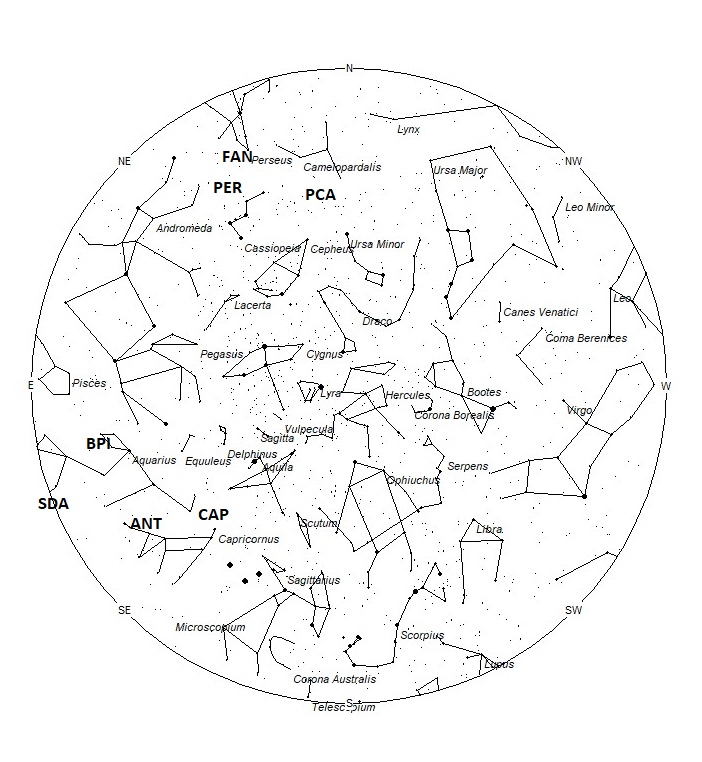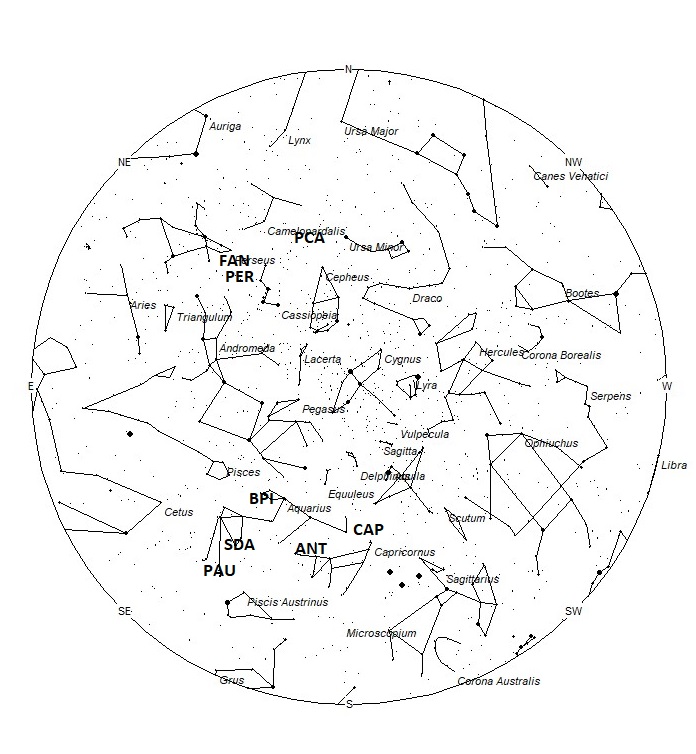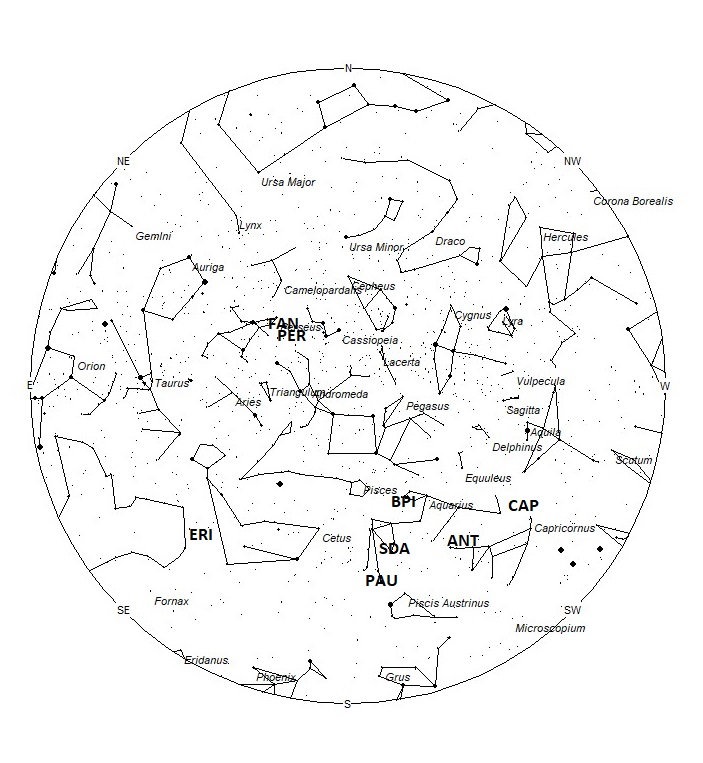
Meteor activity kicks into high gear in August as seen from the northern hemisphere. The main reason for all this activity is the Perseid shower that peaks on August 12th. This shower is active most of the month and remains above the level of the sporadic background for a week centered on August 12th. The sporadic activity is also near maximum as seen from the northern hemisphere and is now more than double the rates from just three months ago. As seen from southern hemisphere, meteor rates are still decent but falling rapidly. The sporadic rates continue their downward slide and the Perseid radiant does not rise high into the sky as seen in the southern hemisphere. Therefore, rates for the Perseids are greatly reduced when compared to those seen from the northern hemisphere.
During this period, the moon reaches its full phase on Monday August 3rd. At this time, the moon is located opposite the sun and remains above the horizon all night long. This weekend the nearly full moon will set an hour prior to dawn, allowing a short but dark glimpse of the early August activity. By Thursday, the short, dark portion of night will have shifted to the evening sky in the hour following dusk. The estimated total hourly meteor rates for evening observers this week is near 3 as seen from mid-northern latitudes and 2 as seen from tropical southern locations (25S). For morning observers, the estimated total hourly rates should be near 10 as seen from mid-northern latitudes (45N) and 9 as seen from tropical southern locations (25S). The actual rates will also depend on factors such as personal light and motion perception, local weather conditions, alertness, and experience in watching meteor activity. Rates are reduced during this period due to moonlight. Note that the hourly rates listed below are estimates as viewed from dark sky sites away from urban light sources. Observers viewing from urban areas will see less activity as only the brighter meteors will be visible from such locations.
The radiant (the area of the sky where meteors appear to shoot from) positions and rates listed below are exact for Saturday night/Sunday morning August 1/2. These positions do not change greatly day to day so the listed coordinates may be used during this entire period. Most star atlases (available at science stores and planetariums) will provide maps with grid lines of the celestial coordinates so that you may find out exactly where these positions are located in the sky. A planisphere or computer planetarium program is also useful in showing the sky at any time of night on any date of the year. Activity from each radiant is best seen when it is positioned highest in the sky, either due north or south along the meridian, depending on your latitude. It must be remembered that meteor activity is rarely seen at the radiant position. Rather they shoot outwards from the radiant, so it is best to center your field of view so that the radiant lies at the edge and not the center. Viewing there will allow you to easily trace the path of each meteor back to the radiant (if it is a shower member) or in another direction if it is a sporadic. Meteor activity is not seen from radiants that are located far below the horizon. The positions below are listed in a west to east manner in order of right ascension (celestial longitude). The positions listed first are located further west therefore are accessible earlier in the night while those listed further down the list rise later in the night.
These sources of meteoric activity are expected to be active this week.
Details of each source will continue next week when lunar conditions are more suited for viewing meteor activity.
| SHOWER | DATE OF MAXIMUM ACTIVITY | CELESTIAL POSITION | ENTRY VELOCITY | CULMINATION | HOURLY RATE | CLASS |
| RA (RA in Deg.) DEC | Km/Sec | Local Daylight Saving Time | North-South | |||
| alpha Capricornids (CAP) | Jul 26 | 20:30 (309) -09 | 22 | 01:00 | 1 – 1 | II |
| Anthelion (ANT) | – | 21:28 (322) -15 | 30 | 02:00 | 1 – 2 | II |
| August beta Piscids (BPI) | Aug 13 | 22:26 (336) -02 | 41 | 02:00 | <1 – <1 | IV |
| South delta Aquariids (SDA) | Jul 29 | 22:53 (343) -15 | 41 | 03:00 | 1 – 2 | I |
| Piscis Austrinids (PAU) | Aug 08 | 23:08 (347) -23 | 44 | 03:00 | <1 – <1 | II |
| Perseids (PER) | Aug 12 | 02:09 (032) +55 | 59 | 06:00 | 3 – 1 | I |
| eta Eridanids (ERI) | Aug 10 | 02:26 (036) -15 | 65 | 07:00 | <1 – <1 | IV |
| 49 Andromedids (FAN) | Jul 20 | 02:36 (039) +53 | 60 | 07:00 | <1 – <1 | IV |
| psi Cassiopeiids (PCA) | Jul 21 | 02:54 (043) +75 | 42 | 07:00 | <1 – <1 | IV |
 American Meteor Society
American Meteor Society



A perseid question: I was wondering if anyone saw what I saw the second week of August 1976. I was at Meling Ranch in Baja California, between San Telmo and Devil’s Peak, a remote and high location. I saw the biggest thing I have ever seen in sky. Huge object looked bubbly or pockmarked on fire, with much green and blue fire. Could not tell distance. No sound and gone in a bit over a second. Only in recent times did I discover that a meteor hit near Acapulco on August 11, 1976.